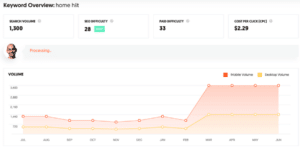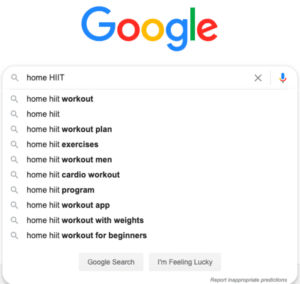Write this down: People aren’t going to wait for the answer. They’ll simply leave your page and go look for what they want somewhere else.
Today’s marketing world is all about providing customers with what they want, right when they want it. It’s no longer enough that you’ve selected a niche or a product that’s popular. Or that you’ve done your keyword research, picked feature images that convert, or built high-quality links. To get real leads that convert, you have to offer exactly what your target audience is looking for. That’s why before you get into actually creating content — whether it’s a pay-per-click, blog, email, or social media post — it’s important that you know and understand the user intent of your chosen topic.
Let’s talk about what user intent is, how you can research it, and where you can find help that’s already winning to give you some serious inspiration.
What is user intent?
The term may sound self-explanatory and simple. Since it’s an important strategy that can make or break your performance online and is often missed by marketers, it’s worth learning more about it.
User intent tells you what people are looking for or want to find when they type a query into a search engine. It considers the keywords used in those queries and goes deeper to understand the context or intention behind the words.
There are three different types of user intent:
- Informational – Users want to learn something and are looking for resources that cover their queries.
- Navigational – People are searching for specific websites that can and will satisfy their search.
- Transactional – Users want to make a purchase and are looking for specific products and services or sites that offer these.

Why does user intent matter?
When we create content, we tend to create what we want other people to learn about. However, this isn’t about us. Not at all. It’s about them.
User intent helps you create content that clearly answers what your audience is looking for so you can meet their specific needs – whether it’s through blogging or even on social media (more on this in a moment). It enables you to achieve higher SEO rankings and conversion rates and maximizes your click-through rates.
Similarly, user intent determines if your page visitors read your content or if they go elsewhere to find better answers to their queries.
Essentially, the goal here is to provide users with exactly what they’re looking for immediately. Otherwise, they’ll leave your page right away and find solutions somewhere else. That’s why understanding and implementing user intent is important for marketers and content creators.
For example, let’s say that you want to write about at-home high-intensity interval training (HIIT) exercises. You then craft an in-depth blog post that’s well-researched and highly optimized with the outline:
- What is HIIT? Where and when did it start?
- Benefits of HIIT exercises
- Testimonials and proven results of HIIT
- Home HIIT exercises
After you publish this, you soon realize that your post is not getting good results. Maybe you’re not even in the search rankings. Most likely it’s because you’re not immediately satisfying the needs of people who search for “at-home HIIT exercises.”
Yes, you’ve provided relevant information and value, but no one is going to read through an entire post just to find the answers they need. “Well, if the information is good enough, they’ll keep reading,” you’re saying. Wrong. It’s not about how good the information is. It’s about how easy you make it for the reader to get the answers that they came for.
This means, to satisfy user intent, you must give them what they’re looking for – right away. Playing hard to get might work in dating, but that’s not the case here.
Now, this doesn’t mean you can’t write about the other details. Of course, you can. And maybe you should. But do so only after you’ve fulfilled the user intent and highlighted the answers they’re searching for.
Wait — Isn’t user intent only important for blogs?
Great question! The answer is a resounding no.
Yes, knowing the user intent for a search query is incredibly helpful when crafting a blog post, because this is going to help you rank. But blogs aren’t the only content you create.
You can take this information and insight you gather and apply it so that you’re also satisfying your audience via social media and email marketing. For example, if people are coming to your Facebook page or subscribing to your email list to learn about new HIIT workouts, then this is exactly what they want! Give it to them.
Therefore, user intent is your BFF through any and all content creation — blogging, social media, email marketing, and beyond.
How can we determine user intent?
Fortunately, discovering and satisfying user intent is not as complicated as it sounds. Here are simple tips you can implement today.
First, determine specific search metrics like the volume of a keyword, CPC (cost per click), competition, related keyword suggestions, seasonal trends, and even content ideas. All of these things will give you a better understanding of what your competitors are doing and what the consumers are searching for on Google. If you need help, Branding Iron research teams are experts in helping define these metrics.
Here’s some sample data using researching “home HIIT.” This shows that the average monthly search volume is 1,300 and it recently saw a huge spike. (This aligns with when the pandemic arrived and quarantine was starting.)

When you scroll further down in the data, you see keyword (read: topic) ideas. This tells you what people online care about when it comes to this topic.
See how this can guide you when you’re creating content for the internet.

Note that this is barely scratching the surface!
Another strategy you can implement is to head on to Google and see what autocompletes your keywords. This will help you find what related searches people are conducting so you can narrow down your general topic into what meets user intent.
Remember, what you see here is not random and it’s not a coincidence. Google is telling you what people are searching for that has to do with “home HIIT.”

Then, you can really narrow down what your audience wants to learn about online.
Great, but what does this all mean?
Let’s keep rolling with our example of at-home HIIT exercises. Take a look at the keyword ideas in one of the previous screenshots. Notice a pattern?
The ideas mostly revolve around exercises and workouts. In other words, this is what people want. They don’t want to know about the history of HIIT or its benefits. They don’t want testimonials or reviews. They want workouts that they can follow, period.
In the sample blog, we referenced, this was the last point we covered, which is why a blog that centers on that keyword but uses the outline we provided would likely fail.
Again, this isn’t to say that the other information isn’t quality or insightful. But it’s not what people want to read about when they search for that query.
Satisfying user intent is your primary goal. Do that first and foremost, and then if you want to include additional information later on in the piece of content, do so.
Write this down: People aren’t going to wait for the answer. They’ll simply leave your page and go look for what they want somewhere else.
Look at what is already succeeding
This is one of the last points that we want to leave you with, and it’s another game-changer.
Pay very close attention to what ranks on the first page of the search results. Google wants to provide the best user experience and makes sure people find what they’re looking for immediately, so they prioritize content and sites that accomplish that.
So, it helps to study what these top-ranking pages are doing for the search query that you want to rank for – how they answer the query, what information they include, how they format their posts, and so on.
If you want to compete with them, then you need to satisfy user intent at least as well as they do.
However, keep in mind that these should only serve as inspiration. Never (ever!) copy what high-ranking pages are doing. Rather, strive to outrank them by creating even better content. This isn’t about stopping at their level. It’s about surpassing them. That’s how you’ll outrank them.
The point is this: You don’t need to reinvent the wheel when it comes to answering user intent. Google already flat-out tells you what people like: It’s the content ranking on page one of the search results. Follow their lead and then go the extra mile with your own content.
The key takeaway
People do online searches to find answers to their problems. With user intent, you can understand what they need and provide solutions to what they’re looking for immediately.
Similarly, we’re not telling you to disregard your SEO best practices of optimizing your blog, adding graphics and social media embeds, or using keywords effectively. These things still matter, and you should still incorporate SEO best practices.
However, Google is getting savvier by the day. What used to be enough to rank well isn’t enough anymore. You can perfectly optimize a piece of content in the traditional sense. If it doesn’t satisfy user intent, then it’s 100% a moot point. Google’s #1 priority is “customer service” — meaning user experience. They want people using the search engine to find what they need as quickly as possible.
Make the user happy and you make Google happy. Subsequently, you’ll be rewarded with better rankings and greater traffic.
Keep following traditional SEO best practices. And in addition, you should take it a step further by offering satisfaction through user intent.
Too much to tackle on your own. Call Branding Iron and we’ll do the heavy lifting for you. It’s that simple. We can help you grow your business while you work on doing what you do best!











